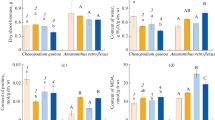Summary
Open stomata of detached leaves of Xanthium strumarium L. closed only when carbon dioxide and abscisic acid (ABA) were presented simultaneously. Three parameters of stomatal closing were determined after additions of ABA to the irrigation water of detached leaves, while the leaves were exposed to various CO2 concentrations ([CO2]s) in the air; a) the delay between addition of ABA and a reduction of stomatal conductance by 5%, b) the velocity of stomatal closing, and c) the new conductance. Changes in all three parameters showed that stomatal responses to ABA were enhanced by CO2; this effect followed saturation kinetics. Half saturation occurred at an estimated [CO2] in the stomatal pore of 200 μl l-1. With respect to ABA, stomata responded in normal air with half their maximal amplitude at [ABA]s between 10-6 and 10-5 M(+-)-ABA. The amounts of ABA taken up by the leaves during the delay increased with a power <1 (on the average, 0.67) of the [ABA] in the transpiration stream. The minimal amount of ABA found to produce a stomatal response was about 1 pmol of (+-)-ABA per cm2 leaf area, almost two orders of magnitude smaller than the original content of the leaves in ABA indicating that most of the endogenous ABA was in a compartment isolated from the guard cells.
An interaction between stomatal responses to CO2 and ABA was also found in Gossypium hirsutum L. and Commelina communis L.; it was however much weaker than in X. strumarium.
Based on earlier findings and on the results of this investigation it is suggested that stomata close if the cytoplasm of the guard cells contains much malate and H+. The acid content in turn is determined by the relative rates of production of malic acid (from endogenous as well as exogenous CO2) and its removal (by transport of the anion into the vacuole and exchange of the H+ for K+ with the environment of the guard cells). The simultaneous requirement of CO2 and ABA for stomatal closure leads to the inference that ABA inhibits the expulsion of H+ from guard cells.
Similar content being viewed by others
Abbreviations
- ABA:
-
abscisic acid
- PEP:
-
phosphoenol pyruvate
References
Allaway, W. G.: Accumulation of malate in guard cells of Vicia faba during stomatal opening. Planta (Berl.) 110, 63–70 (1973)
Cummins, W. R.: The metabolism of abscisic acid in relation to its reversible action on stomata in leaves of Hordeum vulgare L. Planta (Berl.) 114, 159–167 (1973)
Cummins, W. R., Kende, H., Raschke, K.: Specificity and reversibility of the rapid stomatal response to abscisic acid. Planta (Berl.) 99, 347–351 (1971)
Drake, B., Raschke, K.: Prechilling of Xanthium strumarium L. reduces net photosynthesis and, independently, stomatal conductance, while sensitizing the stomata to CO2. Plant Physiol. 53, 808–812 (1974)
Hayward, D. O., Trapnell, B. M. W.: Chemisorption. London: butterworths 1964
Jackson, P. D., Taylor, J. M.: Effects of organic acids on ion uptake and retention in barley roots. Plant Physiol. 46, 538–542 (1970)
Marrè, E., Lado, P., Ferroni, A., Ballarin Denti, A.: Transmembrane potential increase induced by auxin, benzyladenine and fusicoccin, correlation with proton extrusion and cell enlargement. Plant Sci. Lett. 2, 247–264 (1974)
Mizrahi, Y., Blumenfeld, A., Richmond, A. E.: Abscisic acid and transpiration in leaves in relation to osmotic root stress. Plant Physiol. 46, 169–171 (1970)
Moss, D. N., Rawlins, S. L.: Concentration of carbon dioxide inside leaves. Nature (Lond.) 197, 1320–1321 (1963)
Netter, H.: Theoretische Biochemie. Berlin-Göttingen-Heidelberg: Springer 1959
Raschke, K.: Saturation kinetics of the velocity of stomatal closing in response to CO2. Plant Physiol. 49, 229–234 (1972)
Raschke, K.: Abscisic acid sensitizes stomata to CO2 in leaves of Xanthium strumarium L. Proc. VIII. Internat. Conf. on Plant Growth Substances, Tokyo 1973
Raschke, K.: Simultaneous requirement of ABA and CO2 for the modulation of stomatal conductance in Xanthium strumarium. Plant Physiol., Ann. Suppl. 1974, p. 55.
Raschke, K.: Stomatal action. Ann. Rev. Plant Physiol. 26, 309–340 (1975)
Raschke, K., Humble, G. D.: No uptake of anions required by opening stomata of Vicia faba: guard cells release hydrogen ions. Planta (Berl.) 115, 47–57 (1973)
Rayle, D. L.: Auxin-induced hydrogen-ion secretion in Avena coleoptiles and its implication Planta (Berl.) 114, 63–73 (1973)
Squire, G. R., Mansfield, T. A.: Studies of the mechanism of action of fusicoccin, the fungal toxin that induces wilting, and its interaction with abscisic acid. Planta (Berl.) 105, 71–78 (1972)
Stålfelt, M. G.: The effect of carbon dioxide on hydroactive closure of the stomatal cells. Physiol. Plantarum 12, 691–705 (1959)
Ting, I. P.: Nonautotrophic CO2 fixation and crassulacean acid metabolism. In: Photosynthesis and photorespiration, p. 169–185, Hatch, M. D., Osmond, C. B., Slatyer, R. P., eds. New York-London-Sydney-Toronto: Wiley Interscience 1971
Willmer, C. M., dittrich, P.: Carbon dioxide fixation by epidermal and mesophyll tissues of Tulipa and Commelina. Planta (Berl.) 117, 123–132 (1974)
Zeevaart, J. A. D.: (+)-Abscisic acid content of spinach in relation to photoperiod and water stress. Plant Physiol. 48, 86–90 (1971)
Author information
Authors and Affiliations
Rights and permissions
About this article
Cite this article
Raschke, K. Simultaneous requirement of carbon dioxide and abscisic acid for stomatal closing in Xanthium strumarium L.. Planta 125, 243–259 (1975). https://doi.org/10.1007/BF00385601
Received:
Accepted:
Issue Date:
DOI: https://doi.org/10.1007/BF00385601




